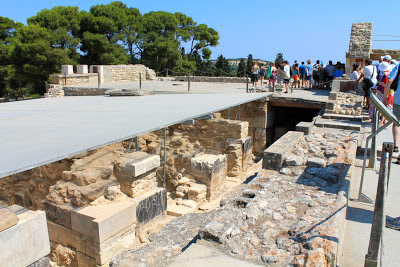Humans are fascinated by
cataclysmic events. The lost city of
Atlantis was once an oasis for humanity, an idyllic Shangri La. But of
course it was destroyed…somehow. There’s a theory suggesting the Greek islands of
Crete and Santorini were once a
single island, and home to Atlantis. Allegedly a massive volcanic eruption split
Crete and Santorini in two, and sunk Atlantis in the process. There is some
geologic evidence of this, but it’s not a foolproof theory. What is foolproof
is a visit to the Palace of Knossos
on the island of Crete is a must if you’re in the region.
The Palace of Knossos was one of four original palaces built
4,000 years ago as cultural and spiritual hubs across the island. I arrived
with the throngs of people to view this amazing complex during the stillness of
a hot July day as the sounds of cicadas and peacocks offered a counterpoint to
the various languages from visitors all over the world. Approaching the Palace it initially looks unimpressive; just
a bunch of large flat stones atop a small mountain. But as you make your way
across said flat stones you begin to realize the depth of this multi faceted
building, literally. This was a four-story behemoth.
At 22,000 square meters (75,000 square feet) Knossos was
built with the sense of proper architecture, order, and a desire to live life
in connection with ones surroundings. The King
and Queen of Minos ruled here as part of the Minoan Empire and their
respective living areas were built to allow air to flow through upper
clerestory openings, taking advantage of the mild evenings keeping the ruling
couple cool during the hot days. Okay, so they are the rulers and sure, they’re
supposed to have the finer things. But hold on. The Minoans on Crete, all of
them, had sewage systems, running water, toilets, even central heating over 1,000
years before the Greeks. A nearby stream once flowed, which provided
water for the Palace and also took their effluent away.
 |
| This staircase is 4,000 years old and you can walk on it |
What is mind boggling, and
one of a handful of utterly unique experiences in life, is walking stone staircases created four thousand years ago, seeing
the clay plumbing pipes, vessels and vases that have withstood the test of time,
some partially reconstructed, some still in their original form. Portions of
the Palace have been rebuilt, anything over three feet tall won’t be original,
and there was a lot of anger in the 1920s when the Palace was partial
reconstructed. It disrupted the natural order of things, and by a British
archeologist no less, they said. It violates the organic nature of the
historical context, and yes that’s partly true. But the small reconstruction
also helps us comprehend what the Palace might have looked like and how it
functioned. Originally unearthed in the 1880s, the Palace’s most thorough
excavation was done by Sir Arthur Evans, who spent 30 years on Crete uncovering
the Palace in all its glory; he unearthed 1,500 rooms in total.
As was true then and is
true today we seek to beautify and embellish our world and the Palace has visible
storage areas, pedestrian thoroughfares, and living quarters with colorful and
decorative motifs. Of particular note to me were the winemaking capabilities
the Cretans had, the bathtubs and all the needs for a working society. There is
an amphitheatre, which many believe is the oldest in Europe. These are ultimately
not the remnants of a forgotten society,
but a stepping-stone to our current world since all that has come before us
impacts on our lives today, even if we don’t readily comprehend it. And that’s
the lesson of visiting Knossos; you innately understand that, though 4,000
years have passed, the needs of a society to be remembered, to build not just
an architectural marvels, but to construct a society which includes the arts,
spiritual and cultural enterprises, is no different than today.
 |
| The King's throne room |
 |
| The Queens room |
You can tour the Palace on your own, spending as much time
as you wish and signs are in Greek and English. You can hire a private guide
who will give you a two-hour history intensive tour, as I did. One is not necessarily
better than the other; however a guide will give you insight you won’t have,
and answer your questions. If you forgo a guide make certain you do some
research in advance to understand the how and the why of the place you are in. The Palace is a modern day museum – a
place to ponder how much has changed in the last four millennia, and yet how
similar life’s fundamentals are. It was thrilling to be here, to walk across
streets that have been traversed for thousands of years by probably thousands
of people, and to be part of a continuum of history.
Getting to the Palace
From Heraklion, Crete’s capital, it’s 30-minutes by car. There’s
a Knossos Palace city bus, and tour buses, which are full day excursions, which
include the Palace as part of a longer itinerary. Admission is €6.
Arrive early
to beat the heat and the crowds, and bring water with you, as there is minimal
shade. If you hire a private guide the cost is about €150 and it’s best to hire
them in advance via a reputable travel agency not on site. There’s a small gift
shop to purchase a walking guide, there’s a café and a few other eateries
across the street. The Palace opens at 8 a.m. and closes as early as 3 p.m. and
as late as 5 p.m.
 |
| 4,000 year old clay plumbing pipes...not bad! |
WATCH my video I shot in Crete: My Big Fat Crete WIne




great place to visit!
ReplyDelete